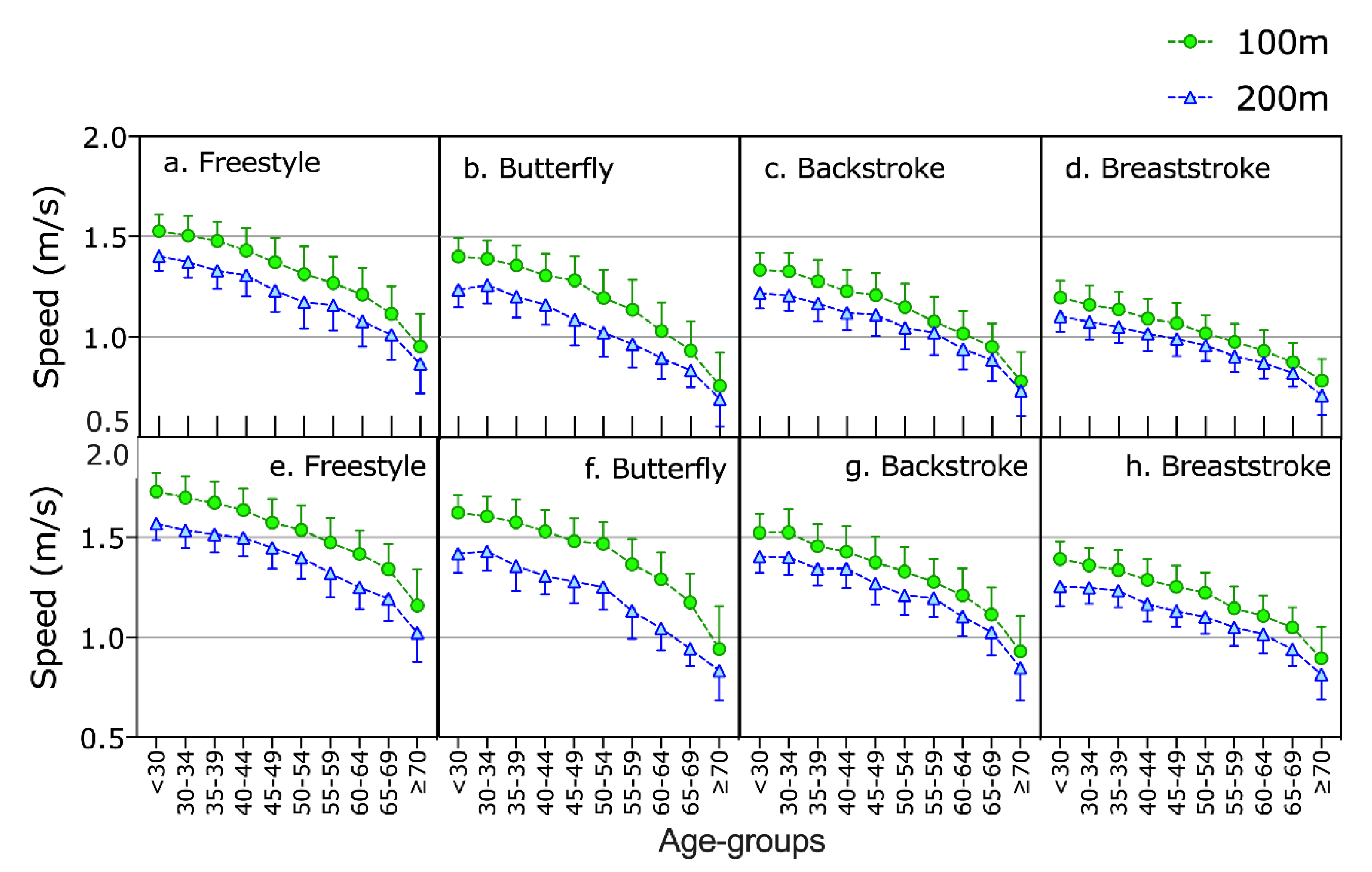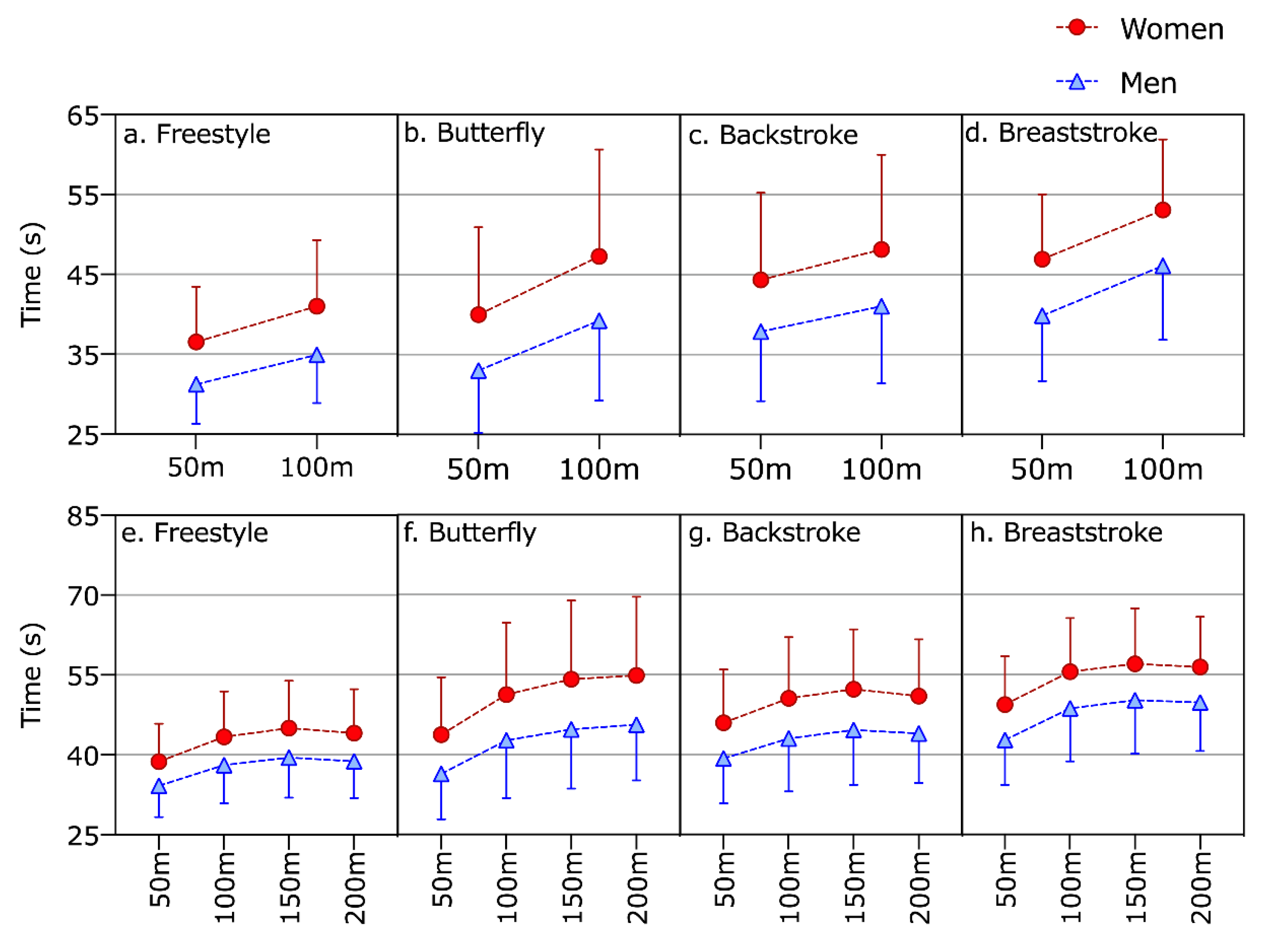Pacing in World-Class Age Group Swimmers in 100 and 200 m Freestyle, Backstroke, Breaststroke, and Butterfly
Abstract
:1. Introduction
2. Materials and Methods
2.1. Ethics Approval
2.2. Data Sampling and Data Analysis
2.3. Statistical Analyses
3. Results
4. Discussion
5. Conclusions
Author Contributions
Funding
Conflicts of Interest
References
- Tanaka, H.; Seals, U.R. Endurance exercise performance in masters athletes: Age-associated changes and underlying physiological mechanisms. J. Physiol. 2007, 586, 55–63. [Google Scholar] [CrossRef] [PubMed]
- Stones, M.J. Age differences, age changes, and generalizability in marathon running by master athletes. Front. Psychol. 2019, 10, 2161. [Google Scholar] [CrossRef] [PubMed] [Green Version]
- Rubin, R. Effects of aging in Masters swimmers: 40-year review and suggestions for optimal health benefits. Open Access J. Sports Med. 2010, 1, 39. [Google Scholar] [CrossRef] [PubMed] [Green Version]
- Knechtle, B.; Nikolaidis, P.T.; König, S.; Rosemann, T.; Rüst, C.A. Performance trends in master freestyle swimmers aged 25–89 years at the FINA World Championships from 1986 to 2014. Age 2016, 38, 1–8. [Google Scholar] [CrossRef] [PubMed]
- Knechtle, B.; Nikolaidis, P.T.; Rosemann, T.; Rüst, C.A. Performance trends in master butterfly swimmers competing in the FINA world championships. J. Hum. Kinet. 2017, 57, 199–211. [Google Scholar] [CrossRef] [PubMed] [Green Version]
- Knechtle, B.; Nikolaidis, P.T.; Rosemann, T.; Rüst, C.A. Performance trends in age group breaststrokes wimmers in the FINA World Championships 1986–2014. Chin. J. Physiol. 2016, 59, 247–259. [Google Scholar] [CrossRef] [PubMed]
- Unterweger, C.M.; Knechtle, B.; Nikolaidis, P.T.; Rosemann, T.; Rüst, C.A. Increased participation and improved performance in age group backstroke master swimmers from 25–29 to 100–104 years at the FINA World Masters Championships from 1986 to 2014. SpringerPlus 2016, 5, 645. [Google Scholar] [CrossRef] [Green Version]
- Damasceno, M.; Pasqua, L.; Lima-Silva, A.; Bertuzzi, R. Energy system contribution in a maximal incremental test: Correlations with pacing and overall performance in a 10-km running trial. Braz. J. Med. Boil. Res. 2015, 48, 1048–1054. [Google Scholar] [CrossRef] [Green Version]
- Thiel, C.; Foster, C.; Banzer, W.; De Koning, J. Pacing in Olympic track races: Competitive tactics versus best performance strategy. J. Sports Sci. 2012, 30, 1107–1115. [Google Scholar] [CrossRef] [Green Version]
- Abbiss, C.; Laursen, P.B. Describing and understanding pacing strategies during athletic competition. Sports Med. 2008, 38, 239–252. [Google Scholar] [CrossRef]
- Nikolaidis, P.T.; Knechtle, B. Pacing in age-group freestyle swimmers at The XV FINA World Masters Championships in Montreal 2014. J. Sports Sci. 2016, 35, 1–8. [Google Scholar] [CrossRef] [PubMed] [Green Version]
- Nikolaidis, P.T.; Knechtle, B. Effect of age and performance on pacing of marathon runners. Open Access J. Sports Med. 2017, 8, 171–180. [Google Scholar] [CrossRef] [PubMed] [Green Version]
- International Swimming Federation (FINA). Available online: www.fina.org/content/fina-masters-world-championships-results-archive (accessed on 1 February 2020).
- International Swimming Federation (FINA). Available online: www.fina.org/discipline/masters (accessed on 1 February 2020).
- Mauger, A.R.; Neuloh, J.; Castle, P.C. Analysis of pacing strategy selection in elite 400-m freestyle swimming. Med. Sci. Sports Exerc. 2012, 44, 2205–2212. [Google Scholar] [CrossRef] [PubMed]
- Wonerow, M.; Rüst, C.A.; Nikolaidis, P.T.; Rosemann, T.; Knechtle, B. Performance trends in age group triathletes in the Olympic distance triathlon at the world championships 2009–2014. Chin. J. Physiol. 2017, 60, 137–150. [Google Scholar] [CrossRef]
- Nikolaidis, P.T.; Cuk, I.; Clemente-Suárez, V.J.; Villiger, E.; Knechtle, B. Number of finishers and performance of age group women and men in long-distance running: Comparison among 10km, half-marathon and marathon races in Oslo. Res. Sports Med. 2020, 1–11. [Google Scholar] [CrossRef]
- Knechtle, B.; Käch, I.; Rosemann, T.; Nikolaidis, P.T. The effect of sex, age and performance level on pacing of Ironman triathletes. Res. Sports Med. 2018, 27, 99–111. [Google Scholar] [CrossRef]
- Allen, S.; Hopkins, W.G. Age of peak competitive performance of elite athletes: A systematic review. Sports Med. 2015, 45, 1431–1441. [Google Scholar] [CrossRef]
- Cuk, I.; Nikolaidis, P.T.; Knechtle, B. Sex differences in pacing during half-marathon and marathon race. Res. Sports Med. 2019, 28, 111–120. [Google Scholar] [CrossRef]
- Reaburn, P.; Dascombe, B. Endurance performance in masters athletes. Eur. Rev. Aging Phys. Act. 2008, 5, 31–42. [Google Scholar] [CrossRef] [Green Version]
- Saavedra, J.M.; Escalante, Y.; García-Hermoso, A.; Arellano, R.; Navarro, F. A 12-year analysis of pacing strategies in 200- and 400-m individual medley in international swimming competitions. J. Strength Cond. Res. 2012, 26, 3289–3296. [Google Scholar] [CrossRef]
- Hanley, B.; Stellingwerff, T.; Hettinga, F.J. Successful pacing profiles of Olympic and IAAF World Championship middle-distance runners across qualifying rounds and finals. Int. J. Sports Physiol. Perform. 2019, 14, 894–901. [Google Scholar] [CrossRef] [PubMed] [Green Version]
- Piras, A.; Cortesi, M.; Campa, F.; Perazzolo, M.; Gatta, G. Recovery time profiling after short-, middle- and long-distance swimming performance. J. Strength Cond. Res. 2019, 33, 1408–1415. [Google Scholar] [CrossRef] [PubMed]
- Robertson, E.Y.; Pyne, D.; Hopkins, W.G.; Anson, J.M. Analysis of lap times in international swimming competitions. J. Sports Sci. 2009, 27, 387–395. [Google Scholar] [CrossRef] [PubMed]
- Zacca, R.; Wenzel, B.; Piccin, J.S.; Marcilio, N.R.; Lopes, A.L.; Castro, F.A.D.S. Critical velocity, anaerobic distance capacity, maximal instantaneous velocity and aerobic inertia in sprint and endurance young swimmers. Graefes Arch. Clin. Exp. Ophthalmol. 2010, 110, 121–131. [Google Scholar] [CrossRef] [PubMed]
- Lipinska, P.; Allen, S.V.; Hopkins, W.G. Relationships between pacing parameters and performance of elite male 1500-m swimmers. Int. J. Sports Physiol. Perform. 2016, 11, 159–163. [Google Scholar] [CrossRef] [PubMed]
- Holfelder, B.; Brown, N.; Bubeck, D. The influence of sex, stroke and distance on the lactate characteristics in high performance swimming. PLoS ONE 2013, 8, e77185. [Google Scholar] [CrossRef]
- Lipinska, P.; Hopkins, W.G. Pacing profiles and competitive performance of elite female 400-m freestyle swimmers. J. Strength Cond. Res. 2020, 34, 218–224. [Google Scholar] [CrossRef] [Green Version]
- Nikolaidis, P.T. Age- and sex-related differences in force-velocity characteristics of upper and lower limbs of competitive adolescent swimmers. J. Hum. Kinet. 2012, 32, 87–95. [Google Scholar] [CrossRef] [Green Version]
- Valenzuela, P.L.; Maffiuletti, N.A.; Joyner, M.J.; Lucia, A.; Lepers, R. Lifelong endurance exercise as a countermeasure against age-related VO2max decline: Physiological overview and insights from masters athletes. Sports Med. 2020, 50, 703–716. [Google Scholar] [CrossRef]
- Snijders, T.; Verdijk, L.B.; Van Loon, L.J.C. The impact of sarcopenia and exercise training on skeletal muscle satellite cells. Aging Res. Rev. 2009, 8, 328–338. [Google Scholar] [CrossRef]
- Hellard, P.; Pla, R.; Rodríguez, F.A.; Simbana, D.; Pyne, D. Dynamics of the metabolic response during a competitive 100-m freestyle in elite male swimmers. Int. J. Sports Physiol. Perform. 2018, 13, 1011–1020. [Google Scholar] [CrossRef] [PubMed] [Green Version]



| Distance | Stroke | Positive Pacing | Negative Pacing |
|---|---|---|---|
| 100 m | Freestyle | 4221 | 13 |
| Butterfly | 1635 | 1 | |
| Backstroke | 1888 | 26 | |
| Breaststroke | 3243 | 5 | |
| 200 m | Freestyle | 2443 | 1 |
| Butterfly | 940 | 0 | |
| Backstroke | 1569 | 2 | |
| Breaststroke | 2074 | 0 |
| Factor | Average Speed | CV | ||
|---|---|---|---|---|
| F | p-Value | F | p-Value | |
| Sex | 114.2 | 0.059 | 9.3 | 0.202 |
| Age group | 446.2 | <0.001 | 1.3 | 0.359 |
| Stroke | 61.5 | 0.003 | 17.1 | 0.022 |
| Distance | 26.4 | 0.014 | 2.5 | 0.209 |
| Sex × Age group | 5.4 | 0.010 | 3.1 | 0.054 |
| Sex × Stroke | 3.5 | 0.164 | 11.2 | 0.039 |
| Sex × Distance | 14.1 | 0.026 | 0.8 | 0.429 |
| Age group × Stroke | 13.9 | <0.001 | 4.0 | <0.001 |
| Age group × Distance | 4.0 | 0.015 | 1.8 | 0.175 |
| Stroke × Distance | 14.3 | 0.017 | 15.4 | 0.013 |
| Sex × Age group × Stroke | 2.3 | 0.015 | 1.8 | 0.070 |
| Sex × Age group × Distance | 1.3 | 0.258 | 0.9 | 0.513 |
| Sex × Stroke × Distance | 5.9 | 0.003 | 4.6 | 0.009 |
| Distance × Age group × Stroke | 1.7 | 0.096 | 1.6 | 0.101 |
| Distance × Sex × Age group × Stroke | 1.0 | 0.458 | 1.3 | 0.136 |
© 2020 by the authors. Licensee MDPI, Basel, Switzerland. This article is an open access article distributed under the terms and conditions of the Creative Commons Attribution (CC BY) license (http://creativecommons.org/licenses/by/4.0/).
Share and Cite
Moser, C.; Sousa, C.V.; Olher, R.R.; Nikolaidis, P.T.; Knechtle, B. Pacing in World-Class Age Group Swimmers in 100 and 200 m Freestyle, Backstroke, Breaststroke, and Butterfly. Int. J. Environ. Res. Public Health 2020, 17, 3875. https://0-doi-org.brum.beds.ac.uk/10.3390/ijerph17113875
Moser C, Sousa CV, Olher RR, Nikolaidis PT, Knechtle B. Pacing in World-Class Age Group Swimmers in 100 and 200 m Freestyle, Backstroke, Breaststroke, and Butterfly. International Journal of Environmental Research and Public Health. 2020; 17(11):3875. https://0-doi-org.brum.beds.ac.uk/10.3390/ijerph17113875
Chicago/Turabian StyleMoser, Cathia, Caio Victor Sousa, Rafael Reis Olher, Pantelis Theodoros Nikolaidis, and Beat Knechtle. 2020. "Pacing in World-Class Age Group Swimmers in 100 and 200 m Freestyle, Backstroke, Breaststroke, and Butterfly" International Journal of Environmental Research and Public Health 17, no. 11: 3875. https://0-doi-org.brum.beds.ac.uk/10.3390/ijerph17113875






